Business Operations Report: Accounting, Team Dynamics, and HR Roles
VerifiedAdded on 2020/11/23
|10
|2242
|71
Report
AI Summary
This report provides a comprehensive overview of business operations, covering essential elements for startups and established businesses. It begins with an introduction to business activities and the importance of accounting, including profit and loss statements and balance sheets. The report delves into team dynamics, outlining stages of team development (forming, storming, norming, performing, and adjourning) and analyzing roles within a team. It also assesses three motivation theories (Hierarchy of Needs, Carrot and Stick, and Motivation Hygiene theory) and describes different leadership styles (autocratic, democratic, strategic, and transformational). Furthermore, the report explores the functions of Human Resources (HR) within a business organization, including training, recruitment, and benefits, while also explaining the key features of employment legislation. The report concludes with a summary of the key findings and a list of references, offering valuable insights for understanding and managing various aspects of business operations.
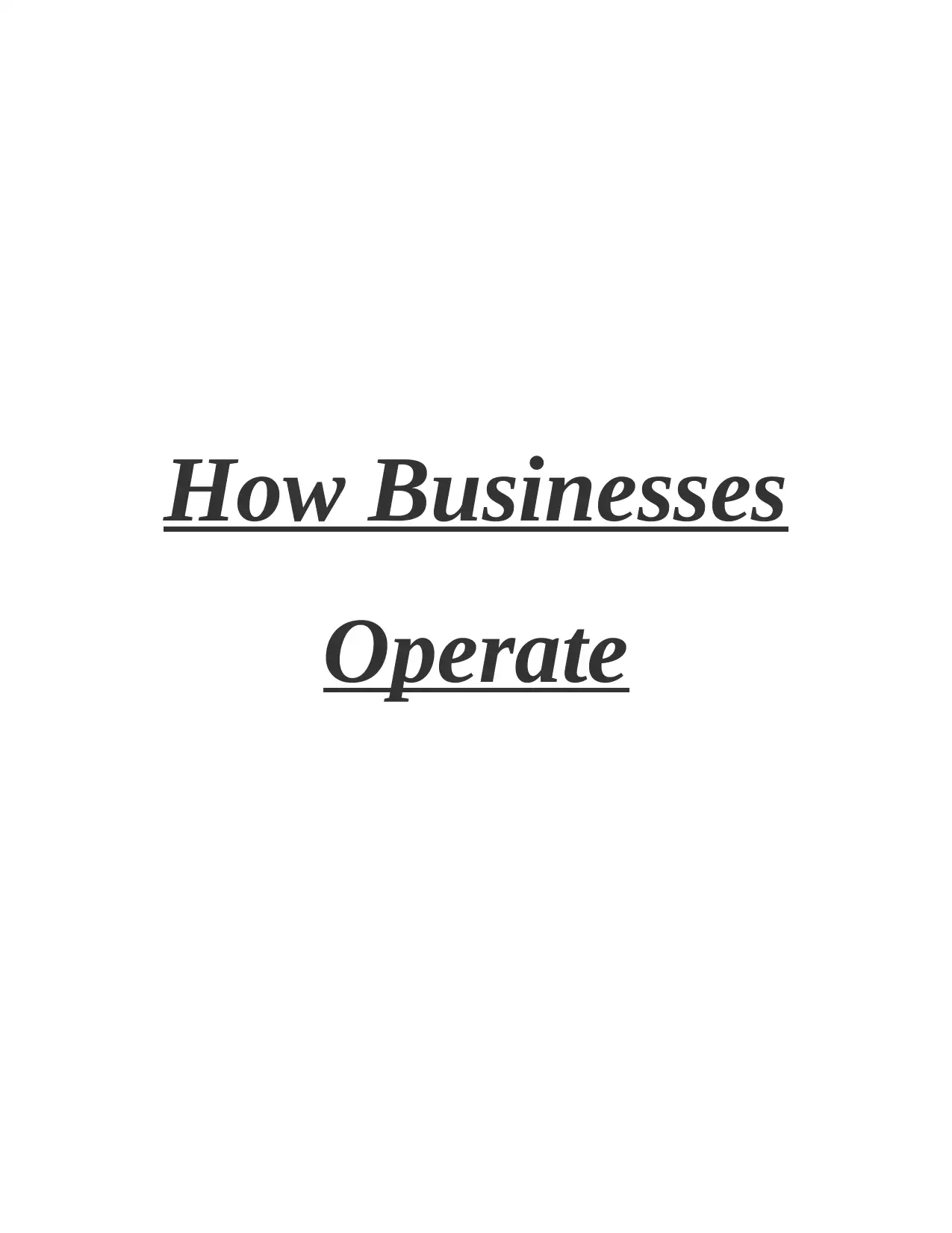
How Businesses
Operate
Operate
Paraphrase This Document
Need a fresh take? Get an instant paraphrase of this document with our AI Paraphraser
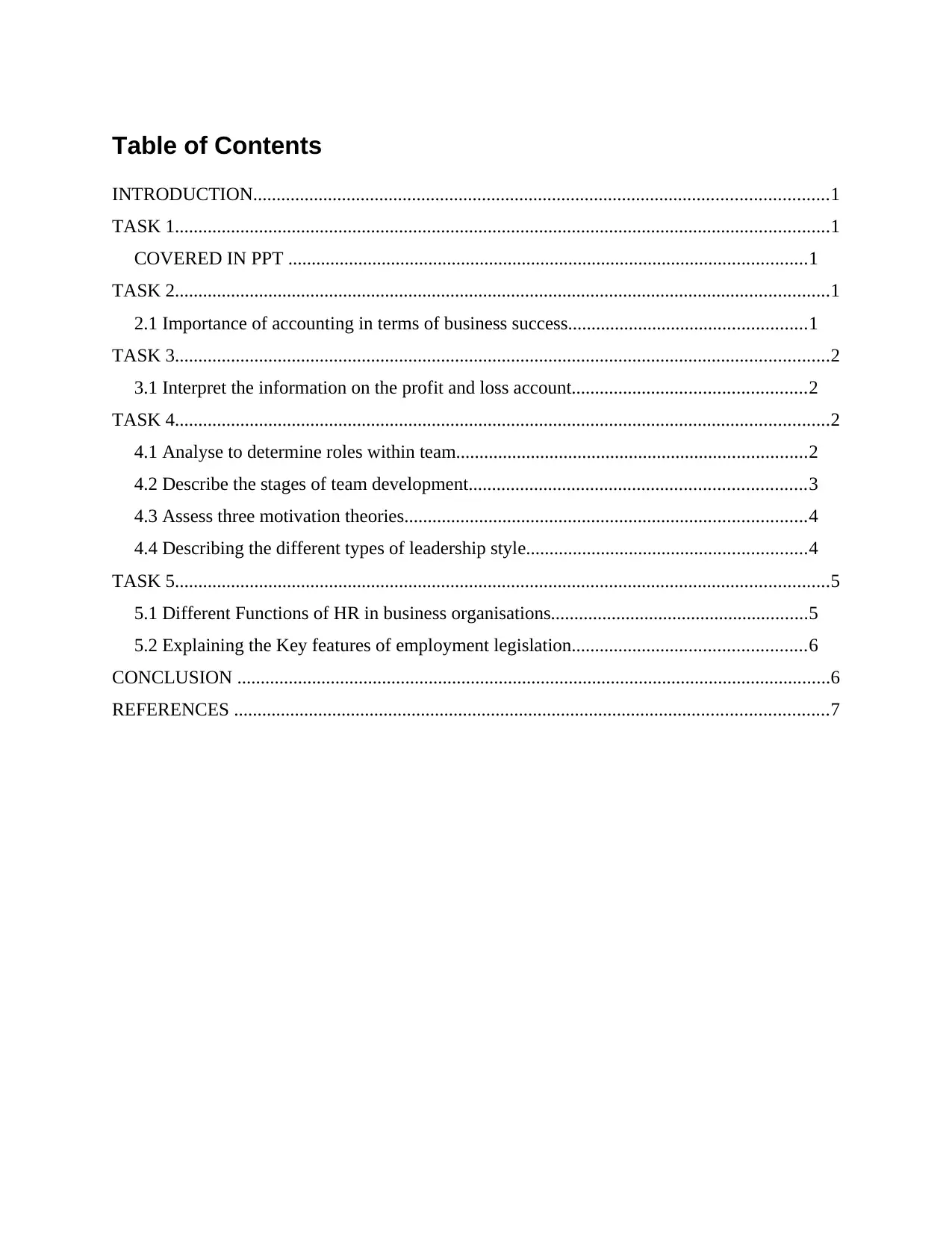
Table of Contents
INTRODUCTION...........................................................................................................................1
TASK 1............................................................................................................................................1
COVERED IN PPT ...............................................................................................................1
TASK 2............................................................................................................................................1
2.1 Importance of accounting in terms of business success...................................................1
TASK 3............................................................................................................................................2
3.1 Interpret the information on the profit and loss account..................................................2
TASK 4............................................................................................................................................2
4.1 Analyse to determine roles within team...........................................................................2
4.2 Describe the stages of team development........................................................................3
4.3 Assess three motivation theories......................................................................................4
4.4 Describing the different types of leadership style............................................................4
TASK 5............................................................................................................................................5
5.1 Different Functions of HR in business organisations.......................................................5
5.2 Explaining the Key features of employment legislation..................................................6
CONCLUSION ...............................................................................................................................6
REFERENCES ...............................................................................................................................7
INTRODUCTION...........................................................................................................................1
TASK 1............................................................................................................................................1
COVERED IN PPT ...............................................................................................................1
TASK 2............................................................................................................................................1
2.1 Importance of accounting in terms of business success...................................................1
TASK 3............................................................................................................................................2
3.1 Interpret the information on the profit and loss account..................................................2
TASK 4............................................................................................................................................2
4.1 Analyse to determine roles within team...........................................................................2
4.2 Describe the stages of team development........................................................................3
4.3 Assess three motivation theories......................................................................................4
4.4 Describing the different types of leadership style............................................................4
TASK 5............................................................................................................................................5
5.1 Different Functions of HR in business organisations.......................................................5
5.2 Explaining the Key features of employment legislation..................................................6
CONCLUSION ...............................................................................................................................6
REFERENCES ...............................................................................................................................7
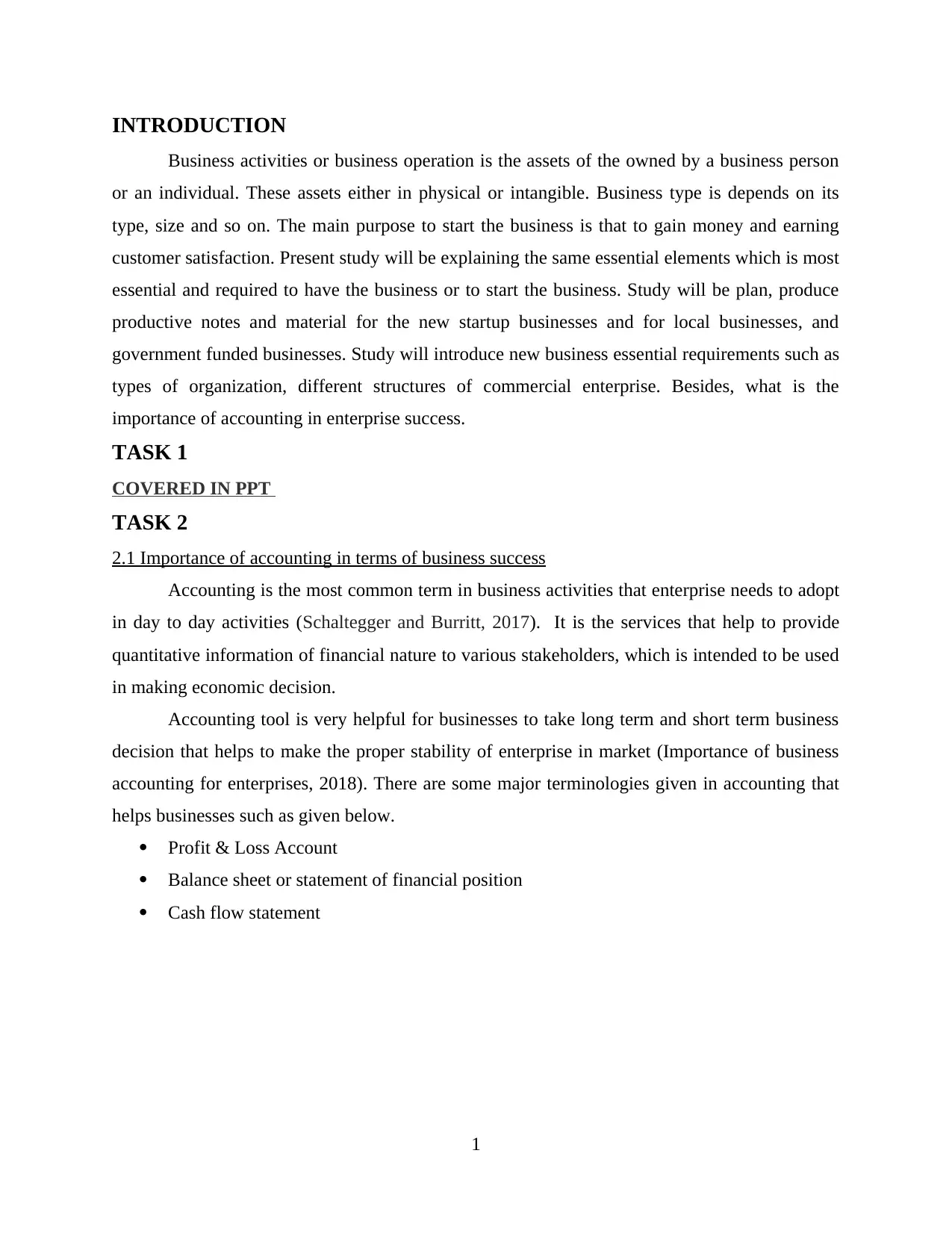
INTRODUCTION
Business activities or business operation is the assets of the owned by a business person
or an individual. These assets either in physical or intangible. Business type is depends on its
type, size and so on. The main purpose to start the business is that to gain money and earning
customer satisfaction. Present study will be explaining the same essential elements which is most
essential and required to have the business or to start the business. Study will be plan, produce
productive notes and material for the new startup businesses and for local businesses, and
government funded businesses. Study will introduce new business essential requirements such as
types of organization, different structures of commercial enterprise. Besides, what is the
importance of accounting in enterprise success.
TASK 1
COVERED IN PPT
TASK 2
2.1 Importance of accounting in terms of business success
Accounting is the most common term in business activities that enterprise needs to adopt
in day to day activities (Schaltegger and Burritt, 2017). It is the services that help to provide
quantitative information of financial nature to various stakeholders, which is intended to be used
in making economic decision.
Accounting tool is very helpful for businesses to take long term and short term business
decision that helps to make the proper stability of enterprise in market (Importance of business
accounting for enterprises, 2018). There are some major terminologies given in accounting that
helps businesses such as given below.
Profit & Loss Account
Balance sheet or statement of financial position
Cash flow statement
1
Business activities or business operation is the assets of the owned by a business person
or an individual. These assets either in physical or intangible. Business type is depends on its
type, size and so on. The main purpose to start the business is that to gain money and earning
customer satisfaction. Present study will be explaining the same essential elements which is most
essential and required to have the business or to start the business. Study will be plan, produce
productive notes and material for the new startup businesses and for local businesses, and
government funded businesses. Study will introduce new business essential requirements such as
types of organization, different structures of commercial enterprise. Besides, what is the
importance of accounting in enterprise success.
TASK 1
COVERED IN PPT
TASK 2
2.1 Importance of accounting in terms of business success
Accounting is the most common term in business activities that enterprise needs to adopt
in day to day activities (Schaltegger and Burritt, 2017). It is the services that help to provide
quantitative information of financial nature to various stakeholders, which is intended to be used
in making economic decision.
Accounting tool is very helpful for businesses to take long term and short term business
decision that helps to make the proper stability of enterprise in market (Importance of business
accounting for enterprises, 2018). There are some major terminologies given in accounting that
helps businesses such as given below.
Profit & Loss Account
Balance sheet or statement of financial position
Cash flow statement
1
⊘ This is a preview!⊘
Do you want full access?
Subscribe today to unlock all pages.

Trusted by 1+ million students worldwide
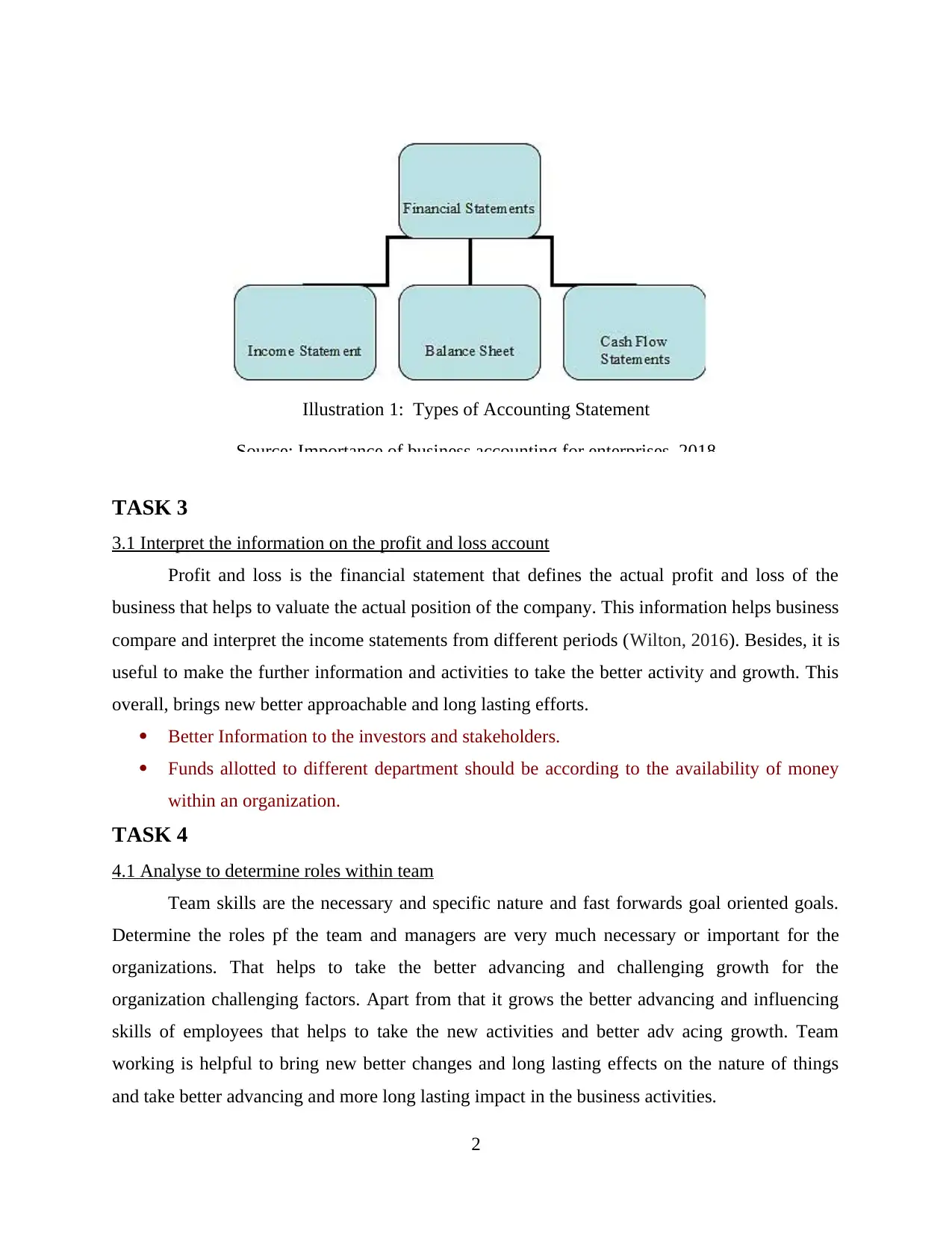
TASK 3
3.1 Interpret the information on the profit and loss account
Profit and loss is the financial statement that defines the actual profit and loss of the
business that helps to valuate the actual position of the company. This information helps business
compare and interpret the income statements from different periods (Wilton, 2016). Besides, it is
useful to make the further information and activities to take the better activity and growth. This
overall, brings new better approachable and long lasting efforts.
Better Information to the investors and stakeholders.
Funds allotted to different department should be according to the availability of money
within an organization.
TASK 4
4.1 Analyse to determine roles within team
Team skills are the necessary and specific nature and fast forwards goal oriented goals.
Determine the roles pf the team and managers are very much necessary or important for the
organizations. That helps to take the better advancing and challenging growth for the
organization challenging factors. Apart from that it grows the better advancing and influencing
skills of employees that helps to take the new activities and better adv acing growth. Team
working is helpful to bring new better changes and long lasting effects on the nature of things
and take better advancing and more long lasting impact in the business activities.
2
Illustration 1: Types of Accounting Statement
Source: Importance of business accounting for enterprises, 2018
3.1 Interpret the information on the profit and loss account
Profit and loss is the financial statement that defines the actual profit and loss of the
business that helps to valuate the actual position of the company. This information helps business
compare and interpret the income statements from different periods (Wilton, 2016). Besides, it is
useful to make the further information and activities to take the better activity and growth. This
overall, brings new better approachable and long lasting efforts.
Better Information to the investors and stakeholders.
Funds allotted to different department should be according to the availability of money
within an organization.
TASK 4
4.1 Analyse to determine roles within team
Team skills are the necessary and specific nature and fast forwards goal oriented goals.
Determine the roles pf the team and managers are very much necessary or important for the
organizations. That helps to take the better advancing and challenging growth for the
organization challenging factors. Apart from that it grows the better advancing and influencing
skills of employees that helps to take the new activities and better adv acing growth. Team
working is helpful to bring new better changes and long lasting effects on the nature of things
and take better advancing and more long lasting impact in the business activities.
2
Illustration 1: Types of Accounting Statement
Source: Importance of business accounting for enterprises, 2018
Paraphrase This Document
Need a fresh take? Get an instant paraphrase of this document with our AI Paraphraser
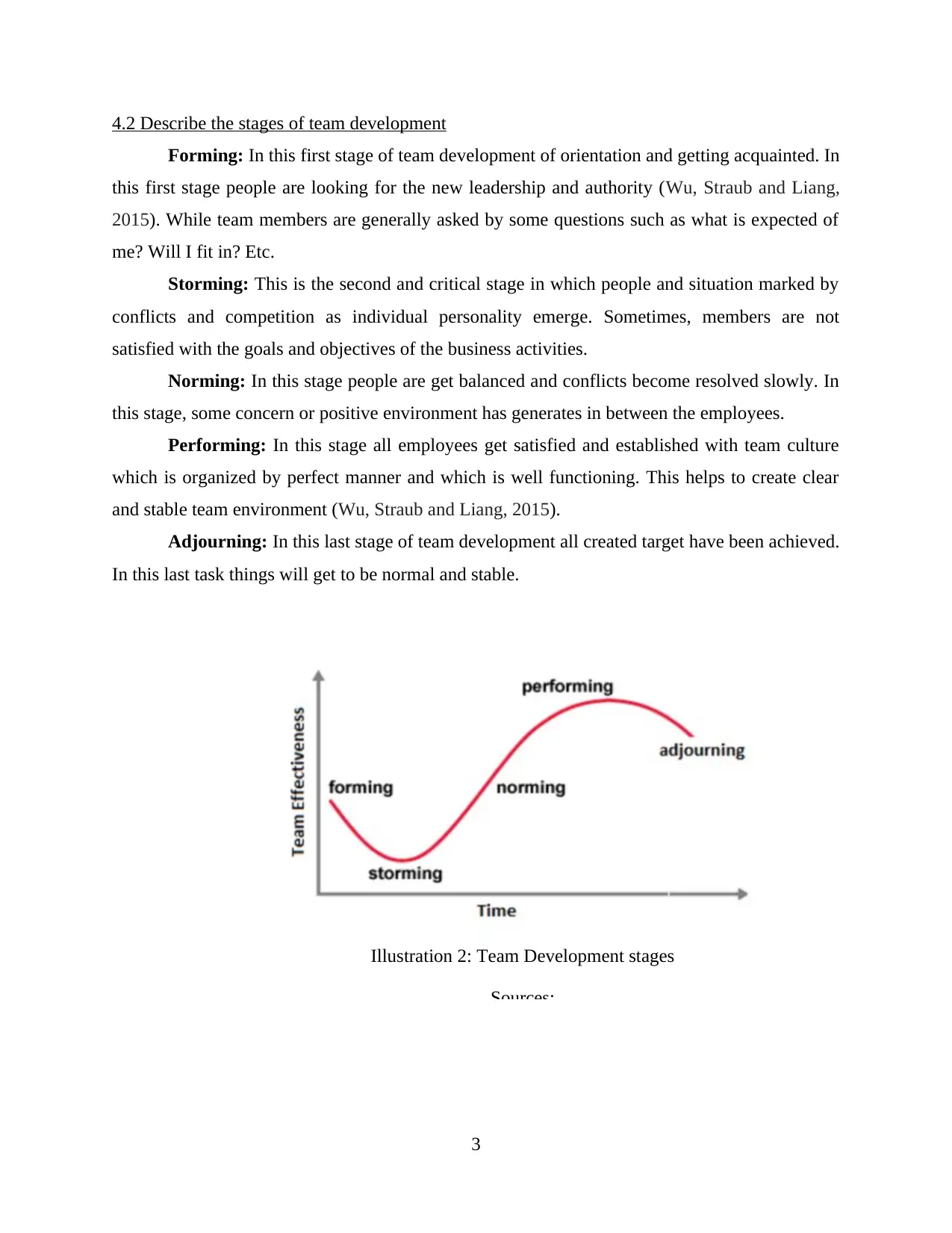
4.2 Describe the stages of team development
Forming: In this first stage of team development of orientation and getting acquainted. In
this first stage people are looking for the new leadership and authority (Wu, Straub and Liang,
2015). While team members are generally asked by some questions such as what is expected of
me? Will I fit in? Etc.
Storming: This is the second and critical stage in which people and situation marked by
conflicts and competition as individual personality emerge. Sometimes, members are not
satisfied with the goals and objectives of the business activities.
Norming: In this stage people are get balanced and conflicts become resolved slowly. In
this stage, some concern or positive environment has generates in between the employees.
Performing: In this stage all employees get satisfied and established with team culture
which is organized by perfect manner and which is well functioning. This helps to create clear
and stable team environment (Wu, Straub and Liang, 2015).
Adjourning: In this last stage of team development all created target have been achieved.
In this last task things will get to be normal and stable.
3
Illustration 2: Team Development stages
Sources:
Forming: In this first stage of team development of orientation and getting acquainted. In
this first stage people are looking for the new leadership and authority (Wu, Straub and Liang,
2015). While team members are generally asked by some questions such as what is expected of
me? Will I fit in? Etc.
Storming: This is the second and critical stage in which people and situation marked by
conflicts and competition as individual personality emerge. Sometimes, members are not
satisfied with the goals and objectives of the business activities.
Norming: In this stage people are get balanced and conflicts become resolved slowly. In
this stage, some concern or positive environment has generates in between the employees.
Performing: In this stage all employees get satisfied and established with team culture
which is organized by perfect manner and which is well functioning. This helps to create clear
and stable team environment (Wu, Straub and Liang, 2015).
Adjourning: In this last stage of team development all created target have been achieved.
In this last task things will get to be normal and stable.
3
Illustration 2: Team Development stages
Sources:
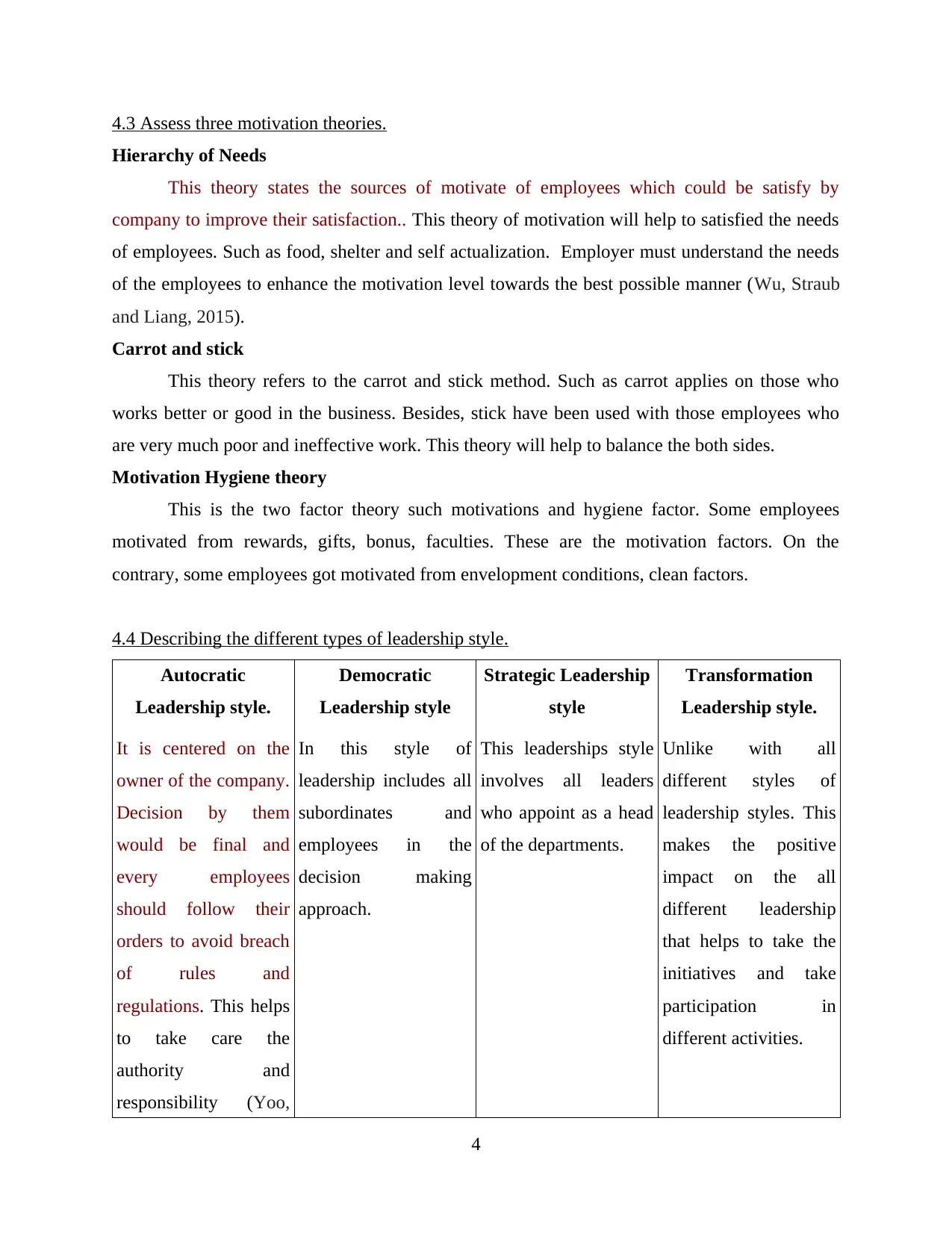
4.3 Assess three motivation theories.
Hierarchy of Needs
This theory states the sources of motivate of employees which could be satisfy by
company to improve their satisfaction.. This theory of motivation will help to satisfied the needs
of employees. Such as food, shelter and self actualization. Employer must understand the needs
of the employees to enhance the motivation level towards the best possible manner (Wu, Straub
and Liang, 2015).
Carrot and stick
This theory refers to the carrot and stick method. Such as carrot applies on those who
works better or good in the business. Besides, stick have been used with those employees who
are very much poor and ineffective work. This theory will help to balance the both sides.
Motivation Hygiene theory
This is the two factor theory such motivations and hygiene factor. Some employees
motivated from rewards, gifts, bonus, faculties. These are the motivation factors. On the
contrary, some employees got motivated from envelopment conditions, clean factors.
4.4 Describing the different types of leadership style.
Autocratic
Leadership style.
Democratic
Leadership style
Strategic Leadership
style
Transformation
Leadership style.
It is centered on the
owner of the company.
Decision by them
would be final and
every employees
should follow their
orders to avoid breach
of rules and
regulations. This helps
to take care the
authority and
responsibility (Yoo,
In this style of
leadership includes all
subordinates and
employees in the
decision making
approach.
This leaderships style
involves all leaders
who appoint as a head
of the departments.
Unlike with all
different styles of
leadership styles. This
makes the positive
impact on the all
different leadership
that helps to take the
initiatives and take
participation in
different activities.
4
Hierarchy of Needs
This theory states the sources of motivate of employees which could be satisfy by
company to improve their satisfaction.. This theory of motivation will help to satisfied the needs
of employees. Such as food, shelter and self actualization. Employer must understand the needs
of the employees to enhance the motivation level towards the best possible manner (Wu, Straub
and Liang, 2015).
Carrot and stick
This theory refers to the carrot and stick method. Such as carrot applies on those who
works better or good in the business. Besides, stick have been used with those employees who
are very much poor and ineffective work. This theory will help to balance the both sides.
Motivation Hygiene theory
This is the two factor theory such motivations and hygiene factor. Some employees
motivated from rewards, gifts, bonus, faculties. These are the motivation factors. On the
contrary, some employees got motivated from envelopment conditions, clean factors.
4.4 Describing the different types of leadership style.
Autocratic
Leadership style.
Democratic
Leadership style
Strategic Leadership
style
Transformation
Leadership style.
It is centered on the
owner of the company.
Decision by them
would be final and
every employees
should follow their
orders to avoid breach
of rules and
regulations. This helps
to take care the
authority and
responsibility (Yoo,
In this style of
leadership includes all
subordinates and
employees in the
decision making
approach.
This leaderships style
involves all leaders
who appoint as a head
of the departments.
Unlike with all
different styles of
leadership styles. This
makes the positive
impact on the all
different leadership
that helps to take the
initiatives and take
participation in
different activities.
4
⊘ This is a preview!⊘
Do you want full access?
Subscribe today to unlock all pages.

Trusted by 1+ million students worldwide
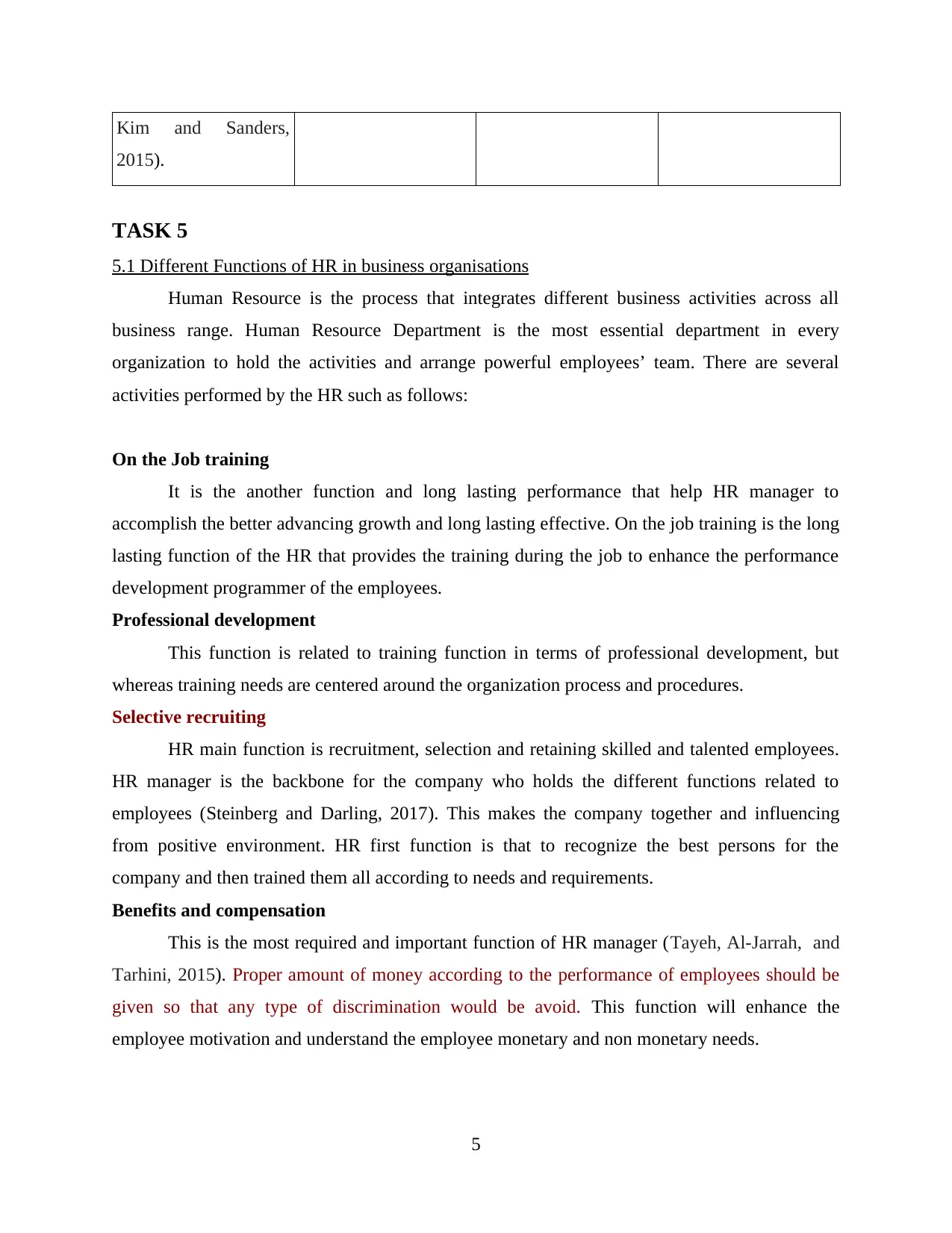
Kim and Sanders,
2015).
TASK 5
5.1 Different Functions of HR in business organisations
Human Resource is the process that integrates different business activities across all
business range. Human Resource Department is the most essential department in every
organization to hold the activities and arrange powerful employees’ team. There are several
activities performed by the HR such as follows:
On the Job training
It is the another function and long lasting performance that help HR manager to
accomplish the better advancing growth and long lasting effective. On the job training is the long
lasting function of the HR that provides the training during the job to enhance the performance
development programmer of the employees.
Professional development
This function is related to training function in terms of professional development, but
whereas training needs are centered around the organization process and procedures.
Selective recruiting
HR main function is recruitment, selection and retaining skilled and talented employees.
HR manager is the backbone for the company who holds the different functions related to
employees (Steinberg and Darling, 2017). This makes the company together and influencing
from positive environment. HR first function is that to recognize the best persons for the
company and then trained them all according to needs and requirements.
Benefits and compensation
This is the most required and important function of HR manager (Tayeh, Al-Jarrah, and
Tarhini, 2015). Proper amount of money according to the performance of employees should be
given so that any type of discrimination would be avoid. This function will enhance the
employee motivation and understand the employee monetary and non monetary needs.
5
2015).
TASK 5
5.1 Different Functions of HR in business organisations
Human Resource is the process that integrates different business activities across all
business range. Human Resource Department is the most essential department in every
organization to hold the activities and arrange powerful employees’ team. There are several
activities performed by the HR such as follows:
On the Job training
It is the another function and long lasting performance that help HR manager to
accomplish the better advancing growth and long lasting effective. On the job training is the long
lasting function of the HR that provides the training during the job to enhance the performance
development programmer of the employees.
Professional development
This function is related to training function in terms of professional development, but
whereas training needs are centered around the organization process and procedures.
Selective recruiting
HR main function is recruitment, selection and retaining skilled and talented employees.
HR manager is the backbone for the company who holds the different functions related to
employees (Steinberg and Darling, 2017). This makes the company together and influencing
from positive environment. HR first function is that to recognize the best persons for the
company and then trained them all according to needs and requirements.
Benefits and compensation
This is the most required and important function of HR manager (Tayeh, Al-Jarrah, and
Tarhini, 2015). Proper amount of money according to the performance of employees should be
given so that any type of discrimination would be avoid. This function will enhance the
employee motivation and understand the employee monetary and non monetary needs.
5
Paraphrase This Document
Need a fresh take? Get an instant paraphrase of this document with our AI Paraphraser
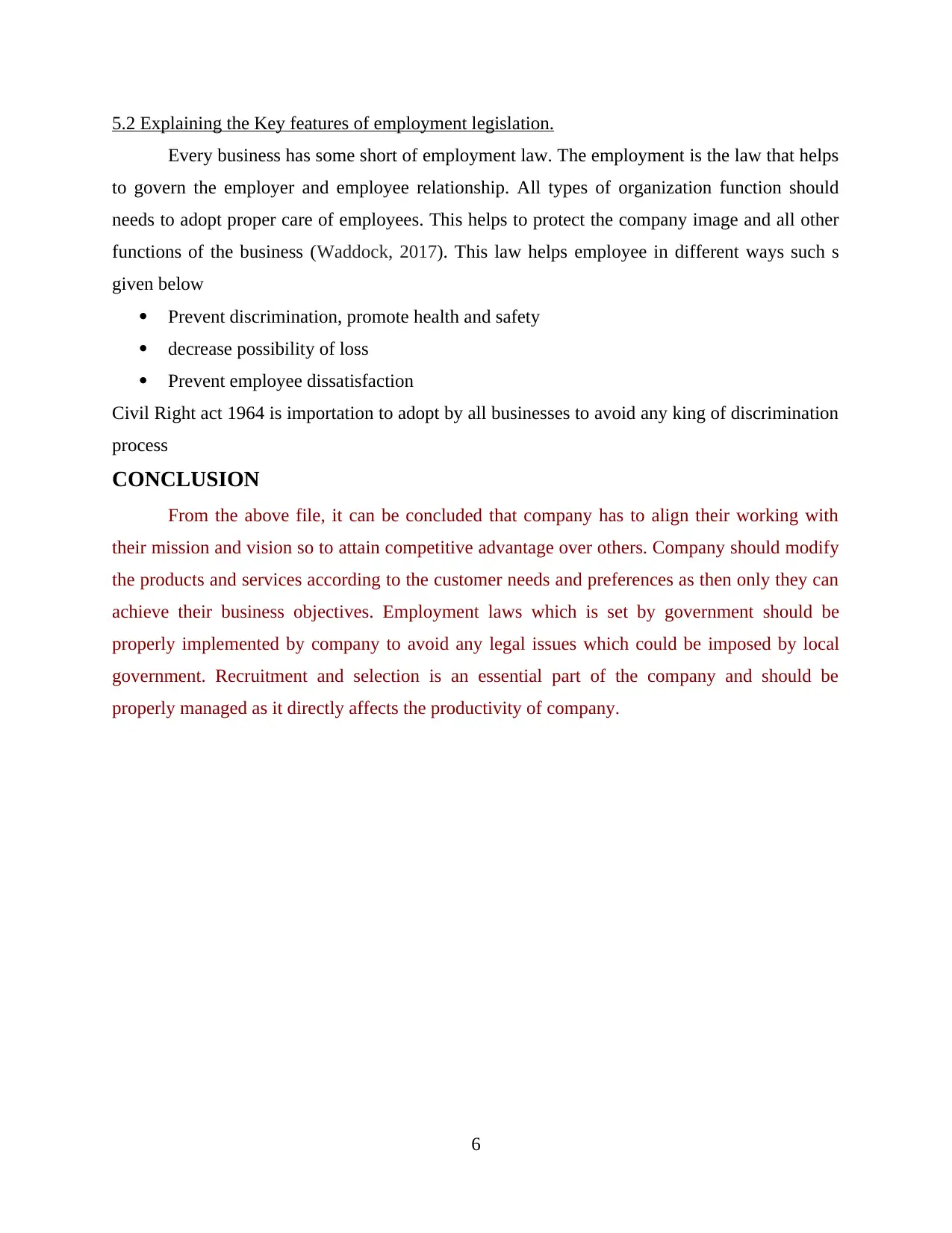
5.2 Explaining the Key features of employment legislation.
Every business has some short of employment law. The employment is the law that helps
to govern the employer and employee relationship. All types of organization function should
needs to adopt proper care of employees. This helps to protect the company image and all other
functions of the business (Waddock, 2017). This law helps employee in different ways such s
given below
Prevent discrimination, promote health and safety
decrease possibility of loss
Prevent employee dissatisfaction
Civil Right act 1964 is importation to adopt by all businesses to avoid any king of discrimination
process
CONCLUSION
From the above file, it can be concluded that company has to align their working with
their mission and vision so to attain competitive advantage over others. Company should modify
the products and services according to the customer needs and preferences as then only they can
achieve their business objectives. Employment laws which is set by government should be
properly implemented by company to avoid any legal issues which could be imposed by local
government. Recruitment and selection is an essential part of the company and should be
properly managed as it directly affects the productivity of company.
6
Every business has some short of employment law. The employment is the law that helps
to govern the employer and employee relationship. All types of organization function should
needs to adopt proper care of employees. This helps to protect the company image and all other
functions of the business (Waddock, 2017). This law helps employee in different ways such s
given below
Prevent discrimination, promote health and safety
decrease possibility of loss
Prevent employee dissatisfaction
Civil Right act 1964 is importation to adopt by all businesses to avoid any king of discrimination
process
CONCLUSION
From the above file, it can be concluded that company has to align their working with
their mission and vision so to attain competitive advantage over others. Company should modify
the products and services according to the customer needs and preferences as then only they can
achieve their business objectives. Employment laws which is set by government should be
properly implemented by company to avoid any legal issues which could be imposed by local
government. Recruitment and selection is an essential part of the company and should be
properly managed as it directly affects the productivity of company.
6
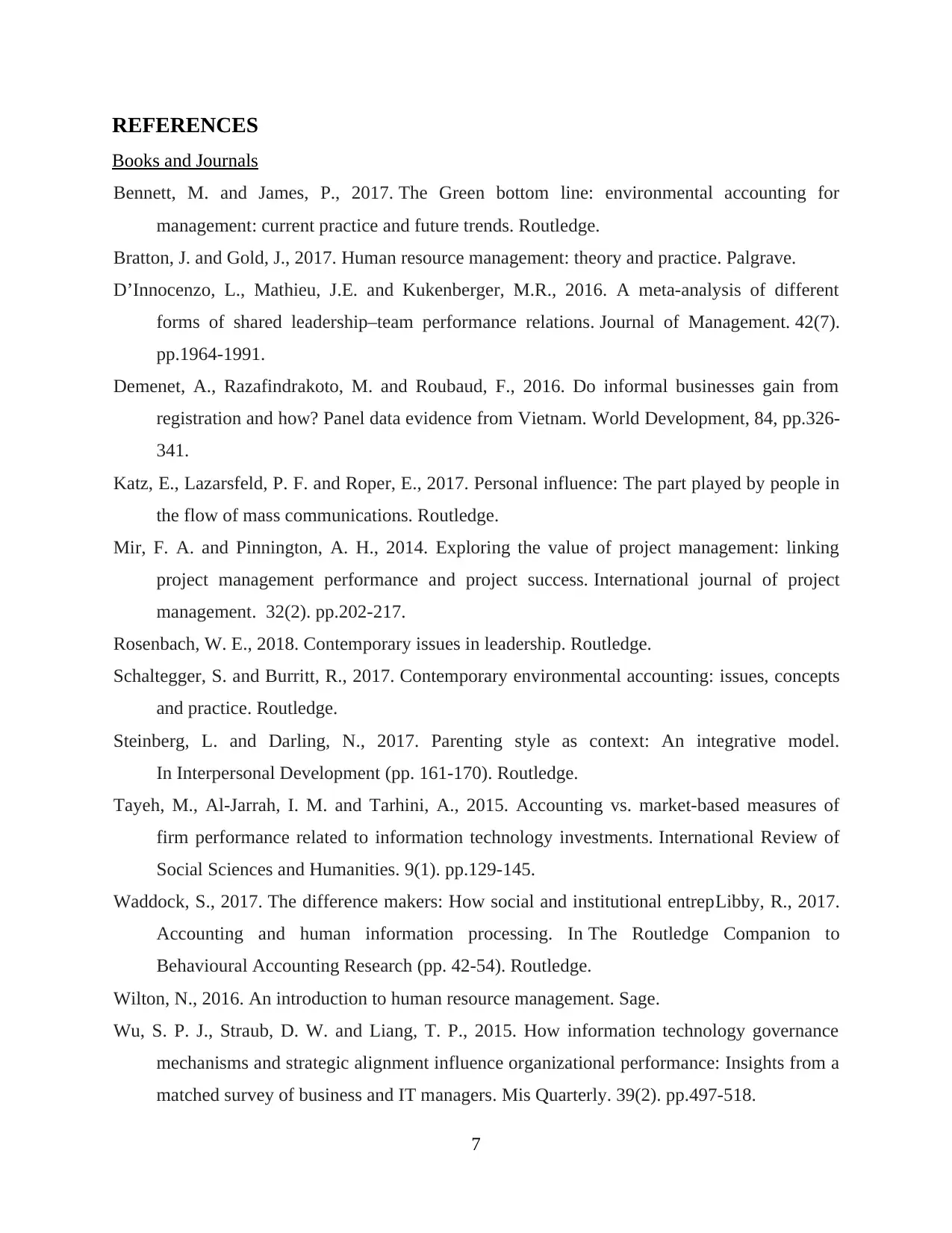
REFERENCES
Books and Journals
Bennett, M. and James, P., 2017. The Green bottom line: environmental accounting for
management: current practice and future trends. Routledge.
Bratton, J. and Gold, J., 2017. Human resource management: theory and practice. Palgrave.
D’Innocenzo, L., Mathieu, J.E. and Kukenberger, M.R., 2016. A meta-analysis of different
forms of shared leadership–team performance relations. Journal of Management. 42(7).
pp.1964-1991.
Demenet, A., Razafindrakoto, M. and Roubaud, F., 2016. Do informal businesses gain from
registration and how? Panel data evidence from Vietnam. World Development, 84, pp.326-
341.
Katz, E., Lazarsfeld, P. F. and Roper, E., 2017. Personal influence: The part played by people in
the flow of mass communications. Routledge.
Mir, F. A. and Pinnington, A. H., 2014. Exploring the value of project management: linking
project management performance and project success. International journal of project
management. 32(2). pp.202-217.
Rosenbach, W. E., 2018. Contemporary issues in leadership. Routledge.
Schaltegger, S. and Burritt, R., 2017. Contemporary environmental accounting: issues, concepts
and practice. Routledge.
Steinberg, L. and Darling, N., 2017. Parenting style as context: An integrative model.
In Interpersonal Development (pp. 161-170). Routledge.
Tayeh, M., Al-Jarrah, I. M. and Tarhini, A., 2015. Accounting vs. market-based measures of
firm performance related to information technology investments. International Review of
Social Sciences and Humanities. 9(1). pp.129-145.
Waddock, S., 2017. The difference makers: How social and institutional entrepLibby, R., 2017.
Accounting and human information processing. In The Routledge Companion to
Behavioural Accounting Research (pp. 42-54). Routledge.
Wilton, N., 2016. An introduction to human resource management. Sage.
Wu, S. P. J., Straub, D. W. and Liang, T. P., 2015. How information technology governance
mechanisms and strategic alignment influence organizational performance: Insights from a
matched survey of business and IT managers. Mis Quarterly. 39(2). pp.497-518.
7
Books and Journals
Bennett, M. and James, P., 2017. The Green bottom line: environmental accounting for
management: current practice and future trends. Routledge.
Bratton, J. and Gold, J., 2017. Human resource management: theory and practice. Palgrave.
D’Innocenzo, L., Mathieu, J.E. and Kukenberger, M.R., 2016. A meta-analysis of different
forms of shared leadership–team performance relations. Journal of Management. 42(7).
pp.1964-1991.
Demenet, A., Razafindrakoto, M. and Roubaud, F., 2016. Do informal businesses gain from
registration and how? Panel data evidence from Vietnam. World Development, 84, pp.326-
341.
Katz, E., Lazarsfeld, P. F. and Roper, E., 2017. Personal influence: The part played by people in
the flow of mass communications. Routledge.
Mir, F. A. and Pinnington, A. H., 2014. Exploring the value of project management: linking
project management performance and project success. International journal of project
management. 32(2). pp.202-217.
Rosenbach, W. E., 2018. Contemporary issues in leadership. Routledge.
Schaltegger, S. and Burritt, R., 2017. Contemporary environmental accounting: issues, concepts
and practice. Routledge.
Steinberg, L. and Darling, N., 2017. Parenting style as context: An integrative model.
In Interpersonal Development (pp. 161-170). Routledge.
Tayeh, M., Al-Jarrah, I. M. and Tarhini, A., 2015. Accounting vs. market-based measures of
firm performance related to information technology investments. International Review of
Social Sciences and Humanities. 9(1). pp.129-145.
Waddock, S., 2017. The difference makers: How social and institutional entrepLibby, R., 2017.
Accounting and human information processing. In The Routledge Companion to
Behavioural Accounting Research (pp. 42-54). Routledge.
Wilton, N., 2016. An introduction to human resource management. Sage.
Wu, S. P. J., Straub, D. W. and Liang, T. P., 2015. How information technology governance
mechanisms and strategic alignment influence organizational performance: Insights from a
matched survey of business and IT managers. Mis Quarterly. 39(2). pp.497-518.
7
⊘ This is a preview!⊘
Do you want full access?
Subscribe today to unlock all pages.

Trusted by 1+ million students worldwide
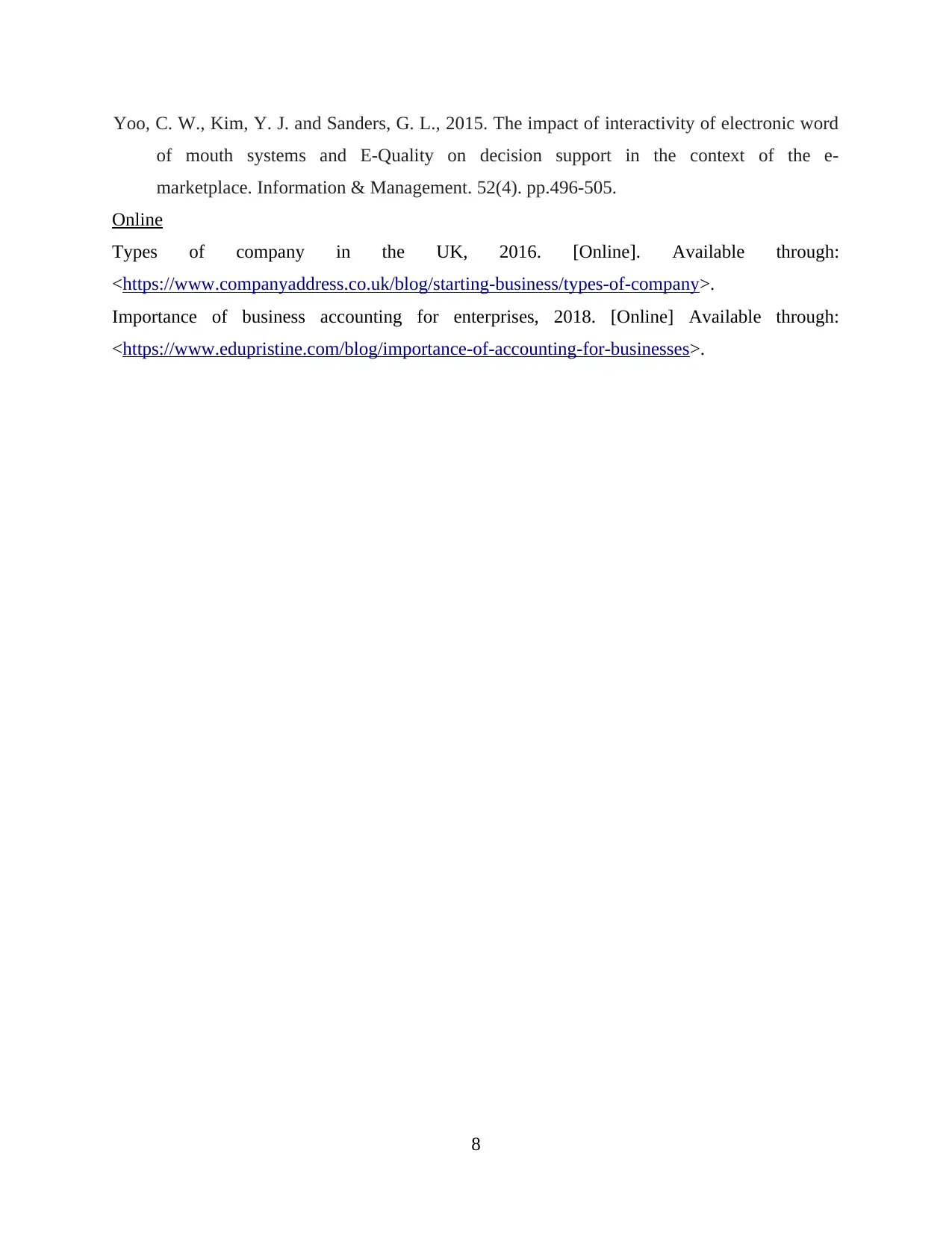
Yoo, C. W., Kim, Y. J. and Sanders, G. L., 2015. The impact of interactivity of electronic word
of mouth systems and E-Quality on decision support in the context of the e-
marketplace. Information & Management. 52(4). pp.496-505.
Online
Types of company in the UK, 2016. [Online]. Available through:
<https://www.companyaddress.co.uk/blog/starting-business/types-of-company>.
Importance of business accounting for enterprises, 2018. [Online] Available through:
<https://www.edupristine.com/blog/importance-of-accounting-for-businesses>.
8
of mouth systems and E-Quality on decision support in the context of the e-
marketplace. Information & Management. 52(4). pp.496-505.
Online
Types of company in the UK, 2016. [Online]. Available through:
<https://www.companyaddress.co.uk/blog/starting-business/types-of-company>.
Importance of business accounting for enterprises, 2018. [Online] Available through:
<https://www.edupristine.com/blog/importance-of-accounting-for-businesses>.
8
1 out of 10
Related Documents
Your All-in-One AI-Powered Toolkit for Academic Success.
+13062052269
info@desklib.com
Available 24*7 on WhatsApp / Email
![[object Object]](/_next/static/media/star-bottom.7253800d.svg)
Unlock your academic potential
Copyright © 2020–2025 A2Z Services. All Rights Reserved. Developed and managed by ZUCOL.





